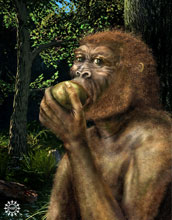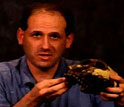News Release 11-088
"Nutcracker Man" Had Fundamentally Different Diet
Scientists: P. boisei probably grazed like ancient warthogs and hippos

"Nutcracker Man" most likely ate grass and possibly sedges.
May 3, 2011
View a video on the diets of early hominids and an interview with Peter Ungar of the University of Arkansas.
This material is available primarily for archival purposes. Telephone numbers or other contact information may be out of date; please see current contact information at media contacts.
An ancient, bipedal hominid needs a new nickname. Paranthropus boisei, a 2.3 million to 1.2 million-year-old primate, whom researchers say is an early human cousin, probably didn't crack nuts at all as his common handle suggests.
"Nutcracker Man" most likely ate grass and possibly sedges, said geochemist Thure Cerling, lead author of a study published in the May 2 online edition of the journal Proceedings of the National Academy of Sciences.
Cerling, a professor of Geology and Geophysics at the University of Utah, and colleagues determined P. boisei's diet by analyzing carbon isotope ratios in the tooth enamel of 24 teeth from 22 P. boisei's individuals. The hominid's diet has been a source of scientific debate because his powerful jaws, huge molars and big, flat cheek teeth indicated he probably fed on nuts and seeds or roots and tubers found in the savannas throughout Eastern Africa.
But, a few years ago, National Science Foundation sponsored research, led by anthropologists at the University of Arkansas in Fayetteville, highlighted inconsistencies with the common view by analyzing scratches and wear marks on P. boisei's teeth.
That team concluded the wear marks were more consistent with modern-day, fruit-eating animals than with most modern-day primates. Now, Cerling as his team confirm P. boisei wasn't a big fan of nuts.
"Wherever we find this creature, it is predominantly eating tropical grasses or perhaps sedges," he said.
The isotope analysis indicated P. boisei individuals preferred C4 grasses and sedges over C3 trees, shrubs and bushes. The findings showed their diets averaged about 77 percent C4 plants, ranging from a low of 61 percent to a high of 91 percent.
That's statistically indistinguishable from the grass diets of grazing animals that lived at the same time: the ancestors of zebras, pigs, warthogs and hippos, said Cerling.
"They were competing with them," he said. "They were eating at the same table."
"Frankly, we didn't expect to find the primate equivalent of a cow dangling from a remote twig of our family tree," said study co-author Matt Sponheimer, anthropology professor at the University of Colorado Boulder.
"Fortunately for us, the work of several research groups over the last several years has begun to soften prevailing notions of early hominid diets. If we had presented our new results at a scientific meeting 20 years ago, we would have been laughed out of the room."
The researchers report the findings in a paper titled, "Diet of Paranthropus boisei in the Early Pleistocene of East Africa." The National Science Foundation's Physical Anthropology Program provided funding for the research.
Other authors included Emma Mbua, Frances Kirera, Fredrick Manthi and Meave Leakey from the National Museums of Kenya, Fredrick Grine from Stony Brook University in New York and Kevin Uno from the University of Utah.
-NSF-
-
View Video
If these teeth could talk.
Credit and Larger Version -
View Video
Nutcracker Man interview in 2008 with anthropologist Peter Ungar, University of Arkansas.
Credit and Larger Version
Media Contacts
Bobbie Mixon, NSF, (703) 292-8485, email: bmixon@nsf.gov
Lee Siegel, University of Utah, (801) 581-8993, email: leesiegel@ucomm.utah.edu
Jim Scott, University of Colorado, (303) 492-3114, email: jim.scott@colorado.edu
Principal Investigators
Thure Cerling, University of Utah, (801) 581-5558, email: tcerling@comcast.net
Co-Investigators
Matt Sponheimer, University of Colorado, (303) 735-2065, email: msponheimer@gmail.com
Related Websites
University of Utah - No Nuts for 'Nutcracker Man': http://www.unews.utah.edu/p/?r=042211-2
University of Colorado - Ancient bipedal hominid dubbed 'Nutcracker Man' preferred grass to nuts, new study finds: http://bit.ly/25XICht
The U.S. National Science Foundation propels the nation forward by advancing fundamental research in all fields of science and engineering. NSF supports research and people by providing facilities, instruments and funding to support their ingenuity and sustain the U.S. as a global leader in research and innovation. With a fiscal year 2023 budget of $9.5 billion, NSF funds reach all 50 states through grants to nearly 2,000 colleges, universities and institutions. Each year, NSF receives more than 40,000 competitive proposals and makes about 11,000 new awards. Those awards include support for cooperative research with industry, Arctic and Antarctic research and operations, and U.S. participation in international scientific efforts.
Connect with us online
NSF website: nsf.gov
NSF News: nsf.gov/news
For News Media: nsf.gov/news/newsroom
Statistics: nsf.gov/statistics/
Awards database: nsf.gov/awardsearch/
Follow us on social
Twitter: twitter.com/NSF
Facebook: facebook.com/US.NSF
Instagram: instagram.com/nsfgov


